Welcome to Meeple Mountain’s review of Meadow, a game packed full of beautiful artwork, lovely components and symbols. Lots and lots of symbols.
The premise of Klemens Kalicki’s Meadow is wonderfully natural – you’re out on a nature walk through nature, naturally looking to see who can spot the best nature. Natch.
A typical turn in this 1-4 player game involves a player choosing a card from a central board then placing a card from their hand on the table in front of them, creating their ‘meadow’ and the wider landscape in which it sits. The cards depict European wildlife and each has at least 2 of the game’s 21 symbols showing the types of habitats or animals that species requires and what it gives your meadow once you’ve played it.
Say you want to add a common blackbird, Turdus merula, to your meadow area. To do that, you’ll have to place the blackbird card partially over a card in your meadow area with a beetle symbol. You decide to cover your starting card, the earth-boring dung beetle Dor, Geotrupes stercorarius. You’ve lost the beetle symbol but gained a bird symbol and a point for your troubles.

This is the essence of Meadow, but it’s Meadow at its most linear.
Rather than a single ladder of cards with each rung providing the next with exactly what it needs, you’ll be building up to 10 columns all interlinked by the multiple symbol requirements that most cards want. The Eurasian lynx, Lynx lynx, needs a bird and two small mammal symbols, requiring 3 columns of cards and a minimum of 6 cards played before it slinks into view and awards you 4 points. That blackbird would do very nicely.
Meadow weaves its growing chains of organisms together, creating an intricate web of dependencies and a compelling puzzle that rewards both planning and reactiveness.

It’s not all animal upon animal however. Landscape cards depict the area you’re walking through, and lead to discovery cards showing mementos you collect on your wanderings. There are combinations of symbols that everyone will be racing to achieve and some limited special actions that might just help you snatch those goals away from your opponents. And the mechanism for how you actually choose cards from the central display is interactive, satisfying and frustrating in equal measures.
Slowly your meadow will spread across the table in front of you to create a beautifully entangled habitat that just so happens to give you lots of leafy points in the process.
But is it any good? To answer that let’s go on a journey through my first three experiences of Meadow because they illustrate what’s great about the game, as well as some things you should be aware of. If we were to plot these experiences, then the curve would look like a smile – high, low, high. Coincidentally that smile is also my final word on the game.
Experience 1: First Encounters
The beginning of 2021 was bitter; a cold, blustery, rain-filled lockdown. In Wales we could ‘only exercise from your front door’, meaning a 2 mile walk from our quiet suburban estate along a polluted main road to get to a park, skirting shattered glass bottles and the occasional dog turd. It’s no wonder we barely left the house.
A prototype copy of Meadow arrived in mid-February, along with an original framed artwork by Meadow’s artist Karolina Kijak. Meadow itself was wrapped in brown paper and tied up with string, with dried flowers and a golden wax seal containing the image of a bee. It was all rather lovely and my nature-loving soul swooned.
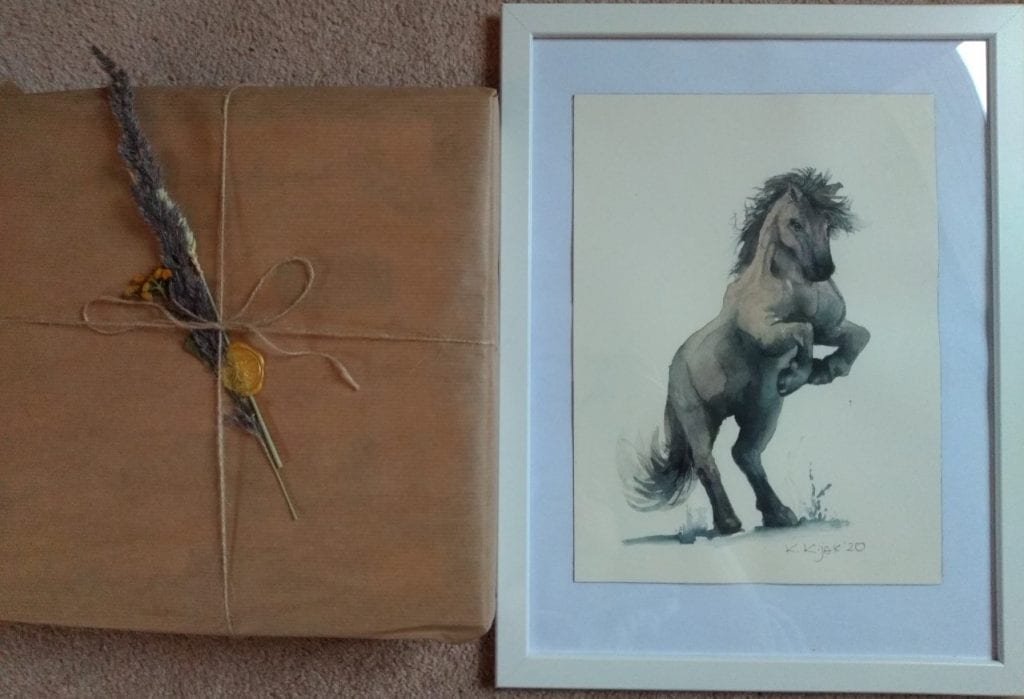
I’m not saying this to suggest that I’ve been influenced by the sweet gesture (although it’s important that you know what I received). Neither am I saying that under Covid-19 prevention measures the arrival of the natural world into my home swept me up in its romance.
Instead, these gestures from Rebel Studio sum up the entire ethos of the game: Meadow is designed and produced by people who care deeply about wildlife and who want you to care too. This love for the natural infuses every element of Meadow, from the gameplay to the components.
And what components they are. If Meadow isn’t nominated for the Diamond Climber Award for Best Artwork of 2021 then I’ll eat that wax seal. Karolina Kijak has done a simply outstanding job. Every time I’ve played Meadow I’ve fallen more in love with the cards. Every time.
The cards are enhanced by two phenomenal design decisions. Firstly, the same care and attention has gone into all the other parts of the game, from the cute card deck holders to the signpost-shaped path tokens that slot cleverly into the (gorgeous) main and campfire boards. Even the thin road tokens are lovely to look at.
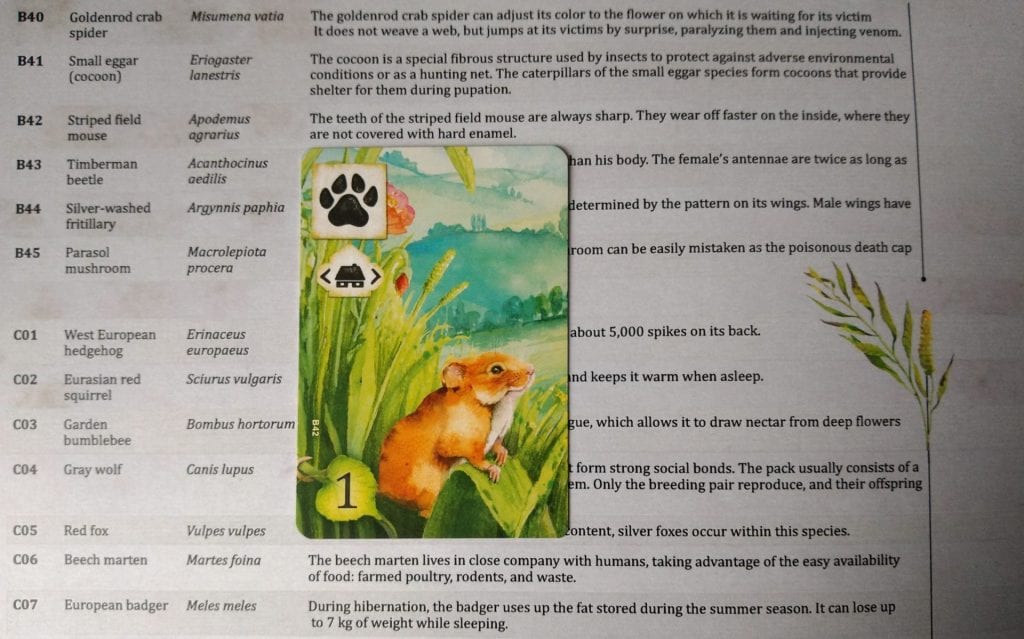
Secondly, the Rebel Studio team have done everything they can to stop the mechanics from getting in the way. The ever present symbols are easily identified but discrete, confined to the edges. The art is allowed to speak for itself.
When we talk about games that stimulate interest in the natural world, 2019’s megahit Wingspan springs immediately to mind. And, to be clear, I think Wingspan is a wonderful game to play and look at but… Wingspan looks like you’re leafing through a birding book. Each card is so crammed full of iconography and information that Wingspan never actually lands its theme. You aren’t attracting birds to a wildlife preserve, you’re just lining up avian trading cards.

Rather than force-feeding you information Meadow puts its wildlife first, stimulating curiosity about its subject in a way that few games manage. The effect is to gently encourage you to find out more. Players discover the interlaced connections between species for themselves, intuitively learning that the natural world isn’t a series of discrete food chains but a complex web of interactions. The team, including graphic designer Katarzyna Fiebiger, deserve a huge amount of credit.
Experience 2: Slowly Getting to Know You
The first time I attempted to play Meadow was with my wife, Lisa. Unfortunately, just after we sat down to play our youngest woke up from a nightmare.
‘It’s my turn.’ said Lisa resignedly, and she disappeared upstairs.
I waited until it became apparent that Meadow wasn’t going to happen that evening, at which point I played through a couple of rounds myself to make sure I understood the rules (rest assured, this gave me no competitive advantage – I’ve never beaten Lisa at Meadow). This wasn’t Meadow’s proper solo mode, just me playing the rules of the multiplayer game alone.
And this was when I discovered that for all of Meadow’s apparent lightness, it has some remarkably slow and ponderous moments. To find out what I mean, let’s talk symbols.
All cards have 2 or more symbols. On your first turn you can see a bare minimum of 50 symbols (16 cards in the central display, 5 cards in your hand, 1 starting card in your meadow area, 1 symbol on your road token and 5-11 goal symbols). This only increases as the game goes on.
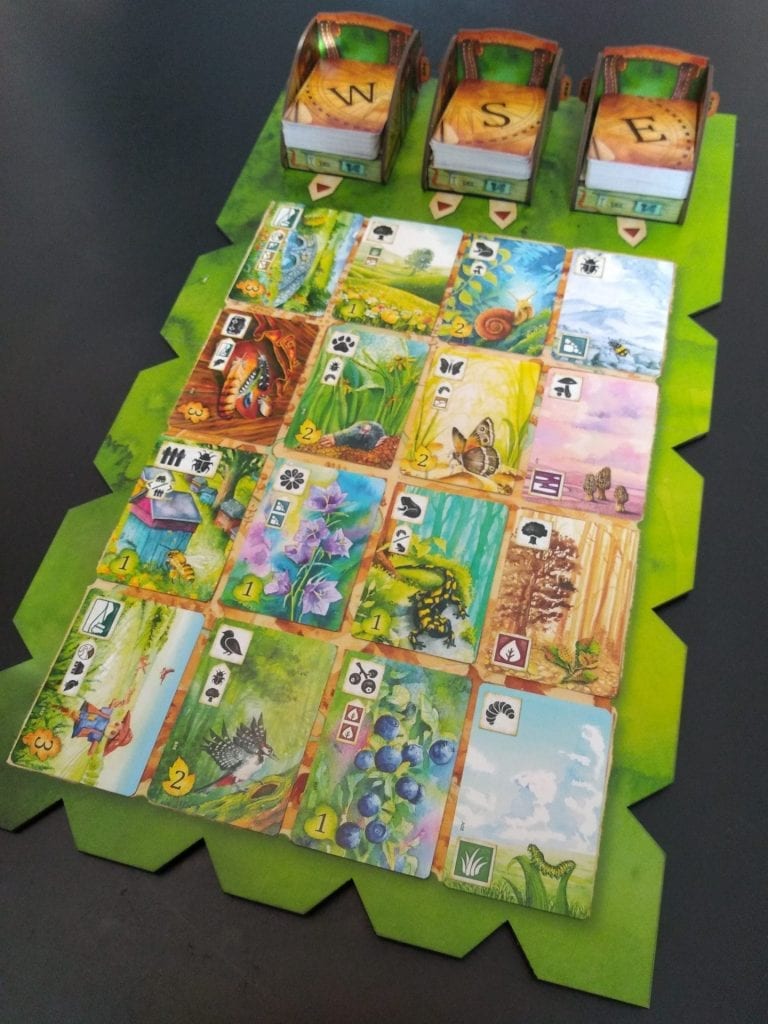
It’s a lot to take in and plotting a route through the symbol landscape can be overwhelming. It’s a feeling that’s compounded by the vast possibility space that you start the game with – what you chose to do is wide open with little indication of what may or may not be best in the long run.
Fast-forward a few turns and the card selection mechanic can slow the game further. To take a card, you insert one of your numbered path tokens into an indent in the central board and take the card that number of spaces along/up the row/column. Insert the number 2 path token and take the second card along. These path tokens also trigger special actions – instead of stabbing the central board you can wodge the blunt end into the campfire board and take that token’s special action. Regardless of what you do, your path token stays there until the end of the round, blocking that space.
Not only are you navigating a tangle of symbols and trying to achieve a myriad of goals, you’re also managing your 4-5 path tokens to give yourself the best options now and later in the round, all whilst getting blocked from the increasingly limited spaces by other players. And I mean limited – Meadow is tight, particularly at higher player counts.
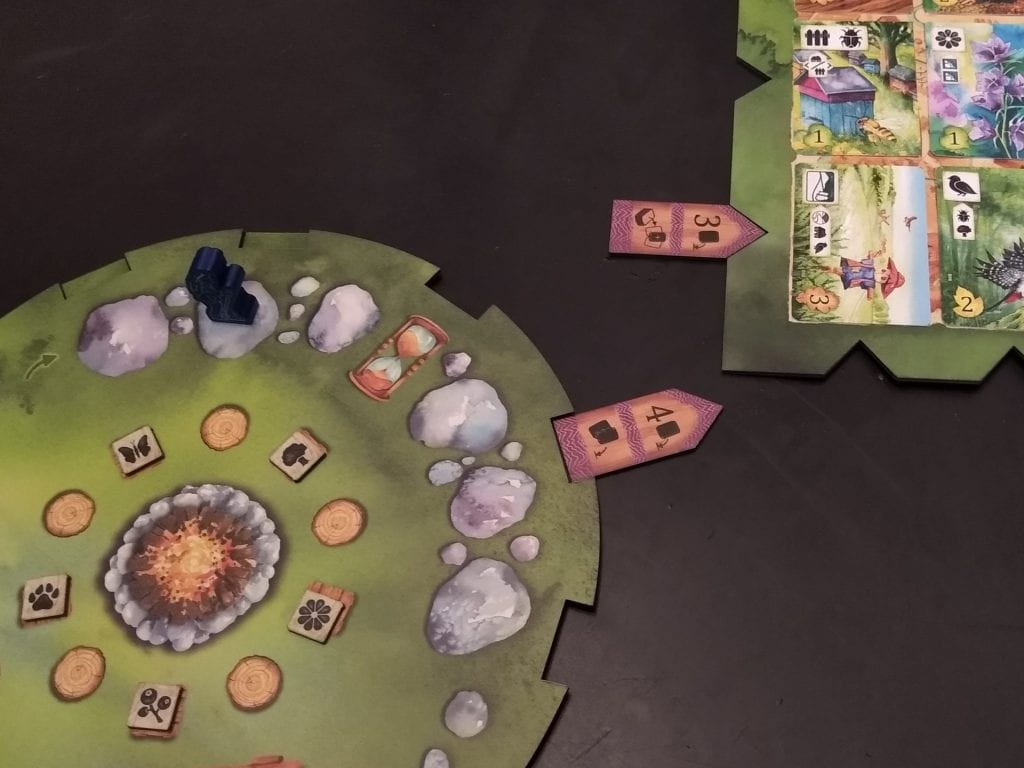
No single element of the thought process is difficult and most turns are quick, but Meadow sometimes grinds to a halt as players think and rethink their options. It’s like you’re mentally mapping a path through a maze, only to hit a dead-end and have to start again.
This all sounds negative, but it’s more that it caught me off guard. Meadow’s rules are fairly simple, the gameplay is streamlined, and it’s a friendly and welcoming box. But from those straightforward seeds blooms a surprisingly complex and interactive ecosystem. Untangling Meadow’s intricacies is incredibly satisfying, but your first couple of rounds may be a bit overwhelming, leaving you feeling a little lost.
Experience 3: Lightning Strikes
A few nights later we managed to play our first game of Meadow, this time without a toddler interrupting.
To begin with I had the same doubts as before: a lot of symbols, a lot of time in thought and a lot of wondering where the fun was. Yet with the scent of competition in the air, the card market moving a little quicker and the possibility space narrowing slightly as the turns went by, Meadow’s momentum slowly built.
And then we did something I’d not done in my first trial: we crossed the half-way point.
Two things happened. Firstly, the card market was refreshed. It’s the only true refresh in the whole game, otherwise cards are just replaced as they’re taken. In a 4 player game a maximum of 3 cards could change between your turns, contributing to Meadow feeling slow. It means that a total refresh is genuinely exciting for the new opportunities it brings.
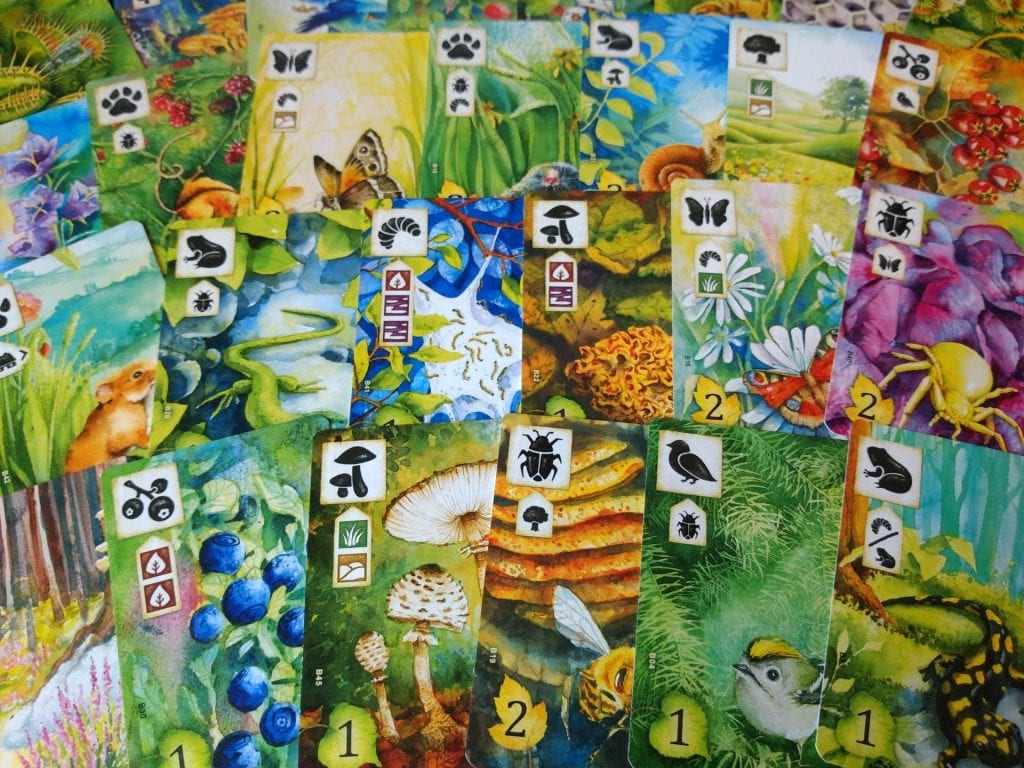
The second thing that happens is that the South deck of cards which is crawling with plants, invertebrates and smaller vertebrates is swapped out for the North deck, which is laden with those at the top of the food chain. Most of these require multiple symbols but bring with them a heady bloom of points.
The combination of the game’s already building momentum and the card market refresh is electrifying. By the half-way point you’ve already got plenty of cards and symbols in your play area and the high-scoring North cards, which would have been difficult at the start of the game, are all the more tempting as a result.

The second half of Meadow goes by in a blur until all too soon you’ve played your last path token and are left to count up the points on your cards and for the goals you claimed on the campfire board. No point multipliers, nothing complex, just some simple addition before comparing scores.
As we looked down at our finished meadows Lisa and I agreed on three things:
- We were very excited to play Meadow again and build on everything we’d just learned.
- For generally non-confrontational players, Meadow made us more directly competitive than most games.
- Meadow is excellent.
The Whole Experience
I’ve had lots of experiences with Meadow since those early moments and I can confidently say that our third point holds true: whilst not completely flawless, Meadow is excellent.
The tightness of the mechanics keeps you on your toes throughout. The glorious artwork keeps you engaged. The interaction between the players, whilst not overtly aggressive, adds a zesty friction. And Meadow’s arc is incredibly rewarding – you start with a humble grub or beetle and by the end you’re left with a functioning ecosystem, one where most of the links you made earlier in the game are completely hidden. It’s not an engine churning out resources or a combo-tastic tableau, its value and reason for existing is entirely based on what it is.
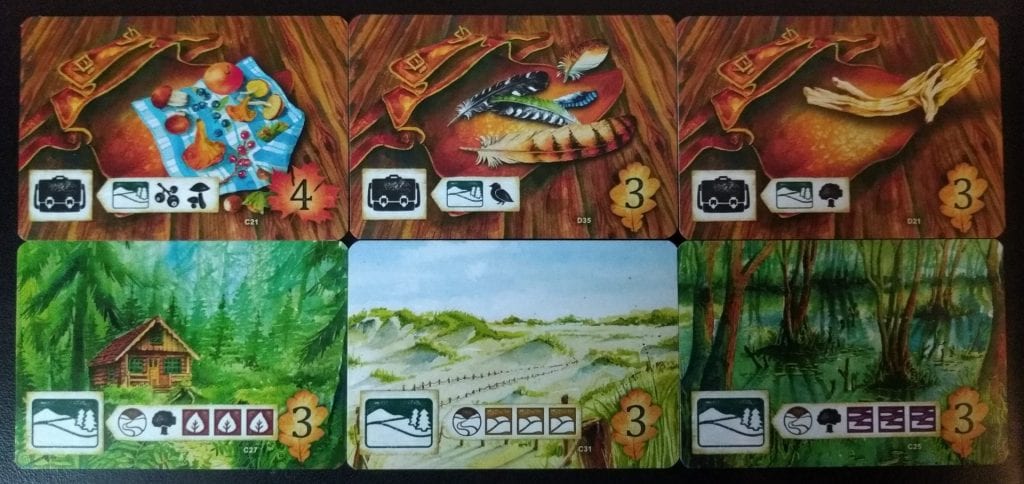
When a plan pays out and you manage to play those cards and snatch that goal before anyone else, Meadow feels incredibly satisfying. When things don’t go to plan, chances are you’ve still created something beautiful. Even the occasional slowness helps to weave the setting and mechanics together to enhance the theme. The time spent thinking about turns and the slow turnover of the card market are indicative of the patience and persistence required to spot wildlife.
I said earlier that Meadow rewards both planning and reactiveness and it’s here that my main criticism emerges. You need to plan a few turns ahead to achieve anything, but you also need to be reactive because you don’t know what cards will emerge from the card decks and because of how tight the board is. Luck can play a role in the end result and sometimes a poor draw or an unfortunate path token choice can cost you. Sure, there’s an element of luck to spotting wildlife but from a gameplay perspective it’s occasionally frustrating.
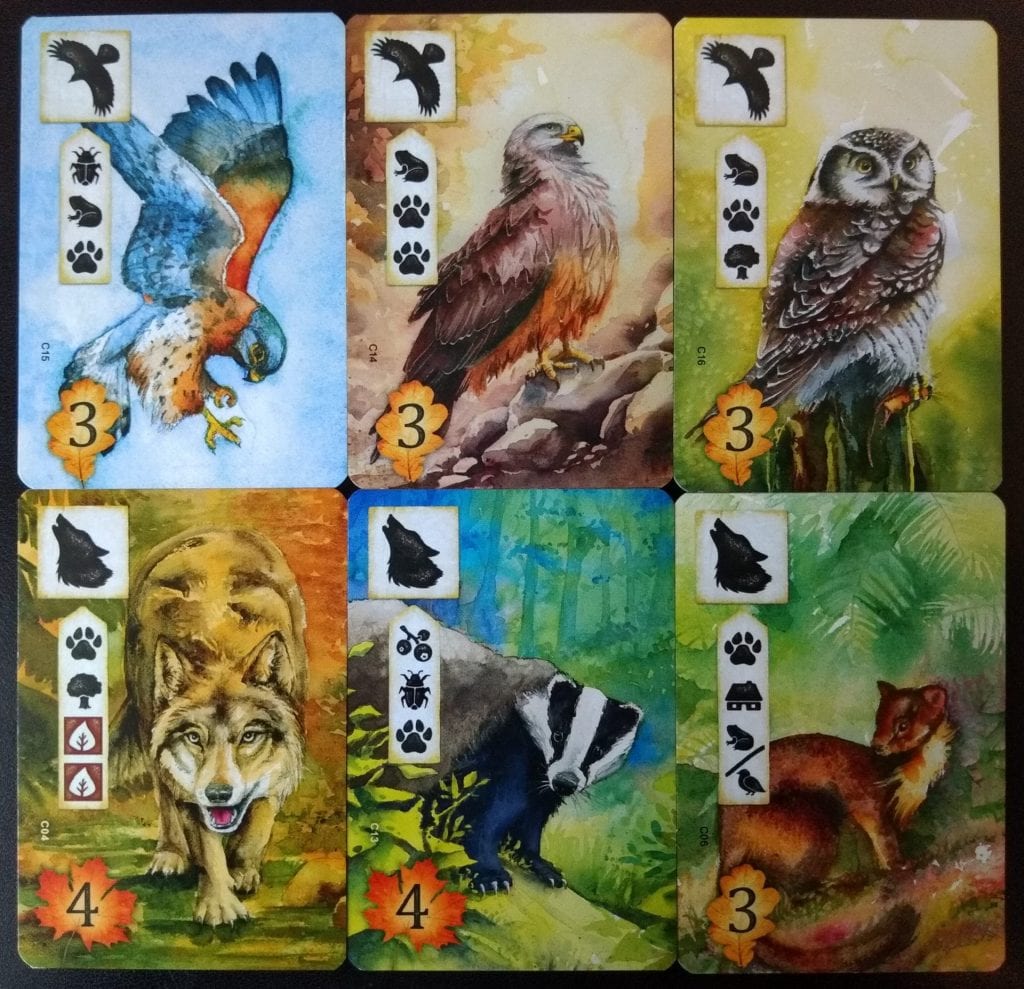
Here’s an extreme but not unlikely example: 2 of the goal symbols are only found in the North deck which comes into play halfway through the game. But all players take 1 random North card at the very start of the game so it’s possible that for half the game 1 player could achieve 2 goals that the rest of the table simply aren’t able to. Even after the halfway point, the meadow you’ve created in the first half of the game might not be well suited to the specific cards that come out in the second half.
In one game I picked up the Peregrine falcon, Falco peregrinus, at the start of the second half. All I needed was a second bird symbol and I could have placed the falcon and claimed a goal. No birds emerged from the decks until the final round and by that stage I didn’t have the right symbols in my meadow to let me place first the bird, then the falcon and then claim the goal in the few turns remaining. My falcon flapped away unseen.

For me this isn’t a big problem, I’m generally more of a reactive player anyway and I feel like it broadly balances out over the course of a game. But if that influence of luck sounds like it would bother you then Meadow might not be for you.
I’m a firm believer that board games can be effective ways of communicating bigger ideas. Perhaps what I like most about Meadow is that it illustrates that life isn’t a linear food chain. Generally we’re brought up to think that life is a hierarchy, the food chain leading from plants to invertebrates to amphibians and so on all the way up to apex predators and, ultimately, us.
But there’s a moment in your first game or two of Meadow that disabuses you of this simplistic notion when you play a card that seems to take you backwards, skipping you down the ladder a rung or two. Suddenly the penny drops and you realise that the world is a lot more complex, interlinked and circular than you previously thought.
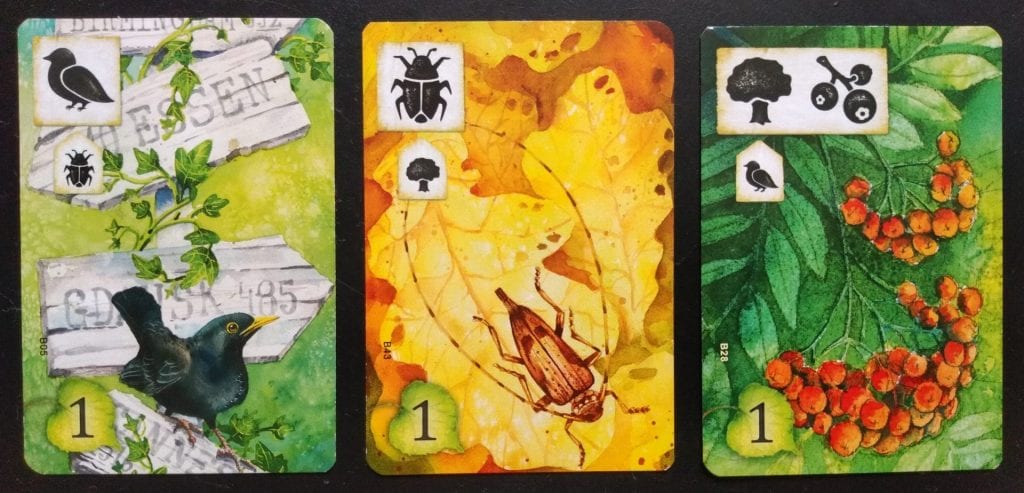
That example I mentioned earlier with the blackbird and the dung beetle? That chain could instead look something like: The blackbird needs a beetle symbol which could be provided by the Timberman beetle, Acvanthocinus aedilis, which in turn requires a tree symbol like the one provided by the Rowan, Sorbus aucuparia, which itself needs a bird symbol (because birds are integral to Rowan seed dispersal) which could be provided by the blackbird you’ve not yet played…
For all its excellent art and mechanics, it’s these organic moments playing Meadow that really make me smile.


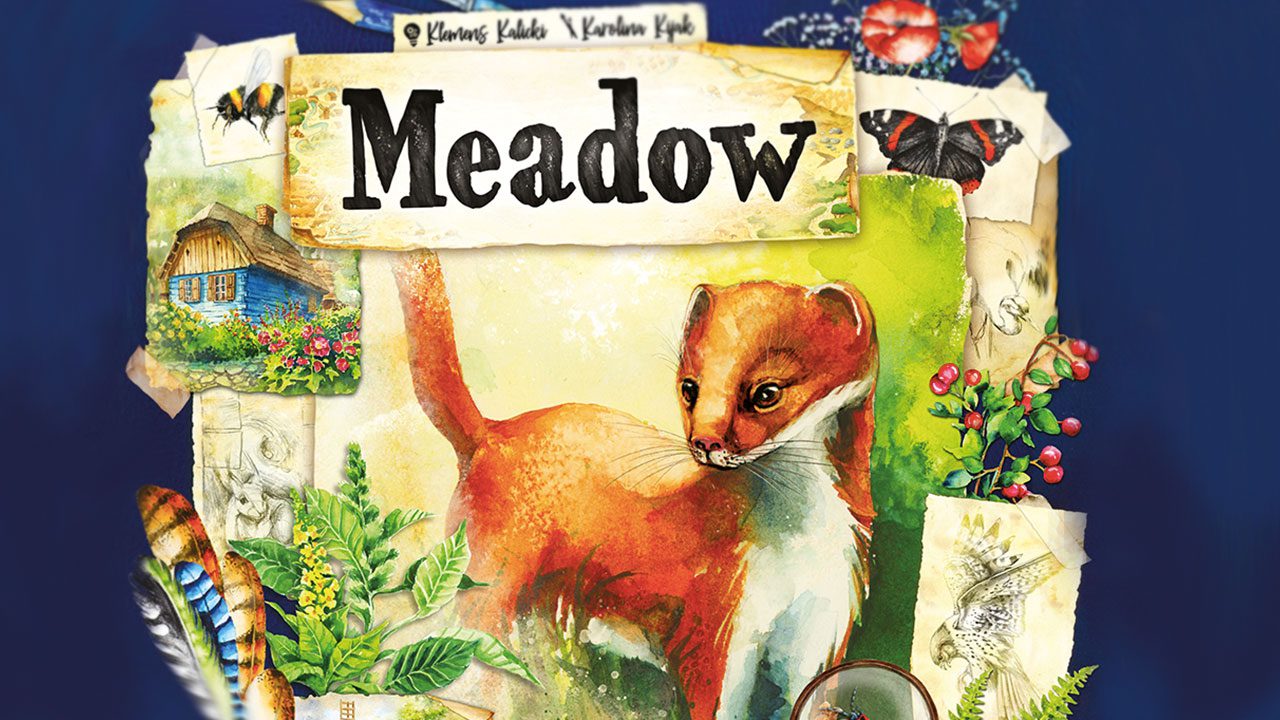




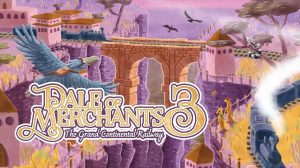




What a wonderfully written review. I just got the game myself because of it. Played four games in three days. Marvelous stuff.
Ah, thank you Donnelle, I’m so pleased you’re enjoying playing Meadow, it’s a fantastic game! 🙂
Loved this review. I’m glad my local store can get this game for me. I knew of Meadow before but your review helped me understand it better than any youtube video I’ve watched. I am excited now.
Thank you Jacob, so glad you found the review useful. I hope you enjoy the game as much as I do!
Thank you for the pin-point card comparison between Wingspan and Meadow! It helps to visualize the stylistic and content difference of the same bird between the 2 games. I love the educational info on Wingspan, but admit the snippet info in small fonts can be eye straining in the evening after work… the meadow features a variety of animals and their ecological connections would be a welcome addition to my table!! Thanks for the wonderful review!!
So glad you enjoyed the review Terry! I really like Wingspan and it’s a beautiful game, but Meadow takes a completely different approach to its wildlife and, for me at least, is far stronger thematically. There’s still tension with the card selection mechanic but I agree that in the evening after work its a more soothing experience. The only shame is that you end up covering up so much of the artwork during the game itself!
I like this style of review. Comparing it to other games and describing in game examples clearly makes your points. I’m sold!
Thanks for the kind words Jacob!